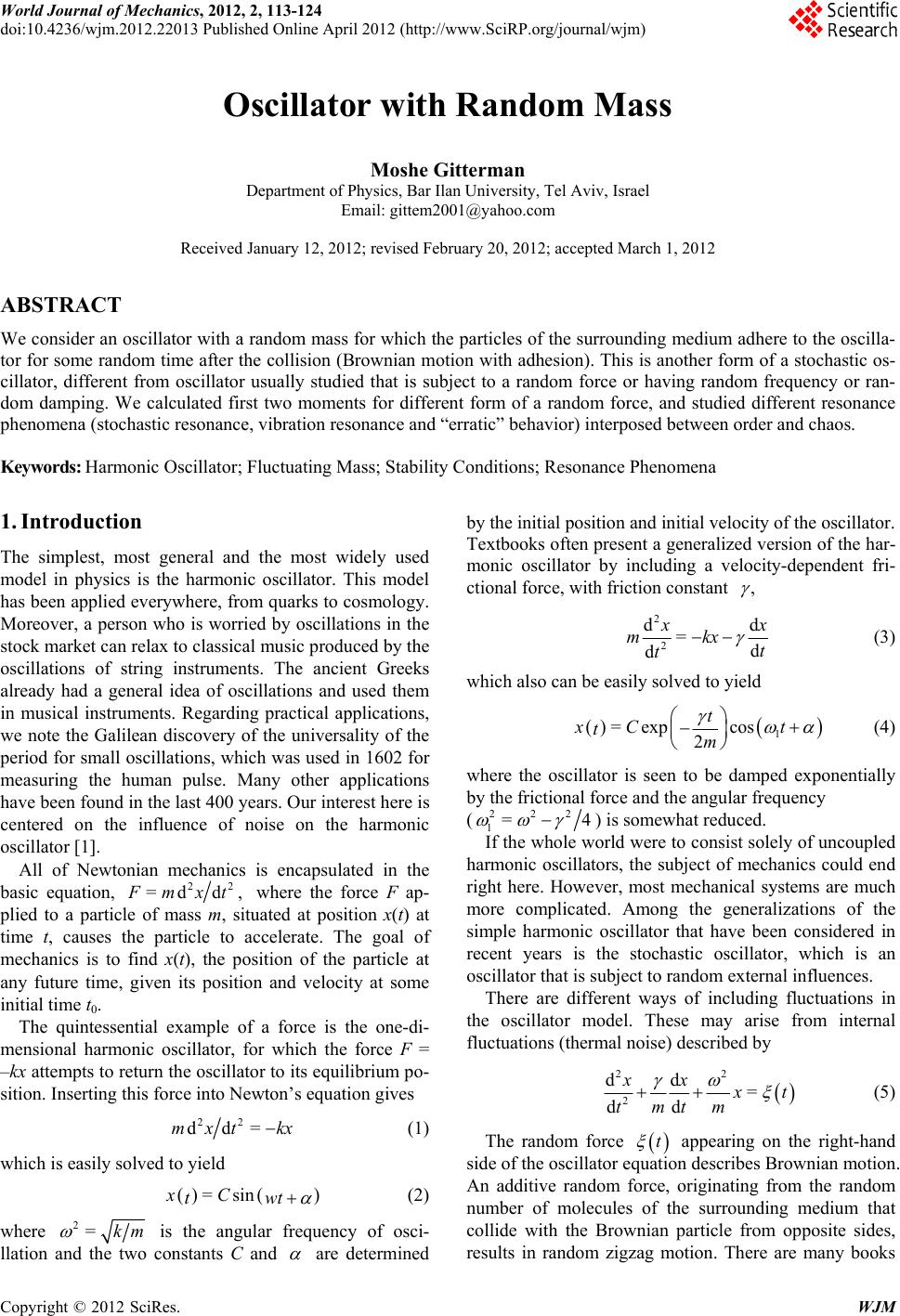 World Journal of Mechanics, 2012, 2, 113-124 doi:10.4236/wjm.2012.22013 Published Online April 2012 (http://www.SciRP.org/journal/wjm) Oscillator with Random Mass Moshe Gitterman Department of Physics, Bar Ilan University, Tel Aviv, Israel Email: gittem2001@yahoo.com Received January 12, 2012; revised February 20, 2012; accepted March 1, 2012 ABSTRACT We consider an oscillator with a random mass for which the particles of the surrounding medium adhere to the oscilla- tor for some random time after the collision (Brownian motion with adhesion). This is another form of a stochastic os- cillator, different from oscillator usually studied that is subject to a random force or having random frequency or ran- dom damping. We calculated first two moments for different form of a random force, and studied different resonance phenomena (stochastic resonance, vibration resonance and “erratic” behavior) interposed between order and chaos. Keywords: Harmonic Oscillator; Fluctuating Mass; Stability Conditions; Resonance Phenomena 1. Introduction The simplest, most general and the most widely used model in physics is the harmonic oscillator. This model has been applied everywhere, from quarks to cosmology. Moreover, a person who is worried by oscillations in the stock market can relax to classical music produced by the oscillations of string instruments. The ancient Greeks already had a general idea of oscillations and used them in musical instruments. Regarding practical applications, we note the Galilean discovery of the universality of the period for small oscillations, which was used in 1602 for measuring the human pulse. Many other applications have been found in the last 400 years. Our interest here is centered on the influence of noise on the harmonic oscillator [1]. All of Newtonian mechanics is encapsulated in the basic equation, 22 =d d, mxt where the force F ap- plied to a particle of mass m, situated at position x(t) at time t, causes the particle to accelerate. The goal of mechanics is to find x(t), the position of the particle at any future time, given its position and velocity at some initial time t0. The quintessential example of a force is the one-di- mensional harmonic oscillator, for which the force F = –kx attempts to return the oscillator to its equilibrium po- sition. Inserting this force into Newton’s equation gives 22 dd=mxt kx (1) which is easily solved to yield =sinxC twt (2) where 2=km is the angular frequency of osci- are determined by the initial position and initial velocity of the oscillator. Textbooks often present a generalized version of the har- monic oscillator by including a velocity-dependent fri- ctional force, with friction constant , 2 dd 2=d d x mkx t t (3) which also can be easily solved to yield 1 =exp cos 2 t xC t tm (4) where the oscillator is seen to be damped exponentially by the frictional force and the angular frequency (222 1=4 ) is somewhat reduced. orld were to consist soleIf the whole wly of uncoupled ha n th rmonic oscillators, the subject of mechanics could end right here. However, most mechanical systems are much more complicated. Among the generalizations of the simple harmonic oscillator that have been considered in recent years is the stochastic oscillator, which is an oscillator that is subject to random external influences. There are different ways of including fluctuations i e oscillator model. These may arise from internal fluctuations (thermal noise) described by 22 ddxx 2= d d t mt m t (5) The random force t uatio appearing on the right-hand side of the oscillator eqn describes Brownian motion. An additive random force, originating from the random number of molecules of the surrounding medium that collide with the Brownian particle from opposite sides, results in random zigzag motion. There are many books llation and the two constants C and Copyright © 2012 SciRes. WJM 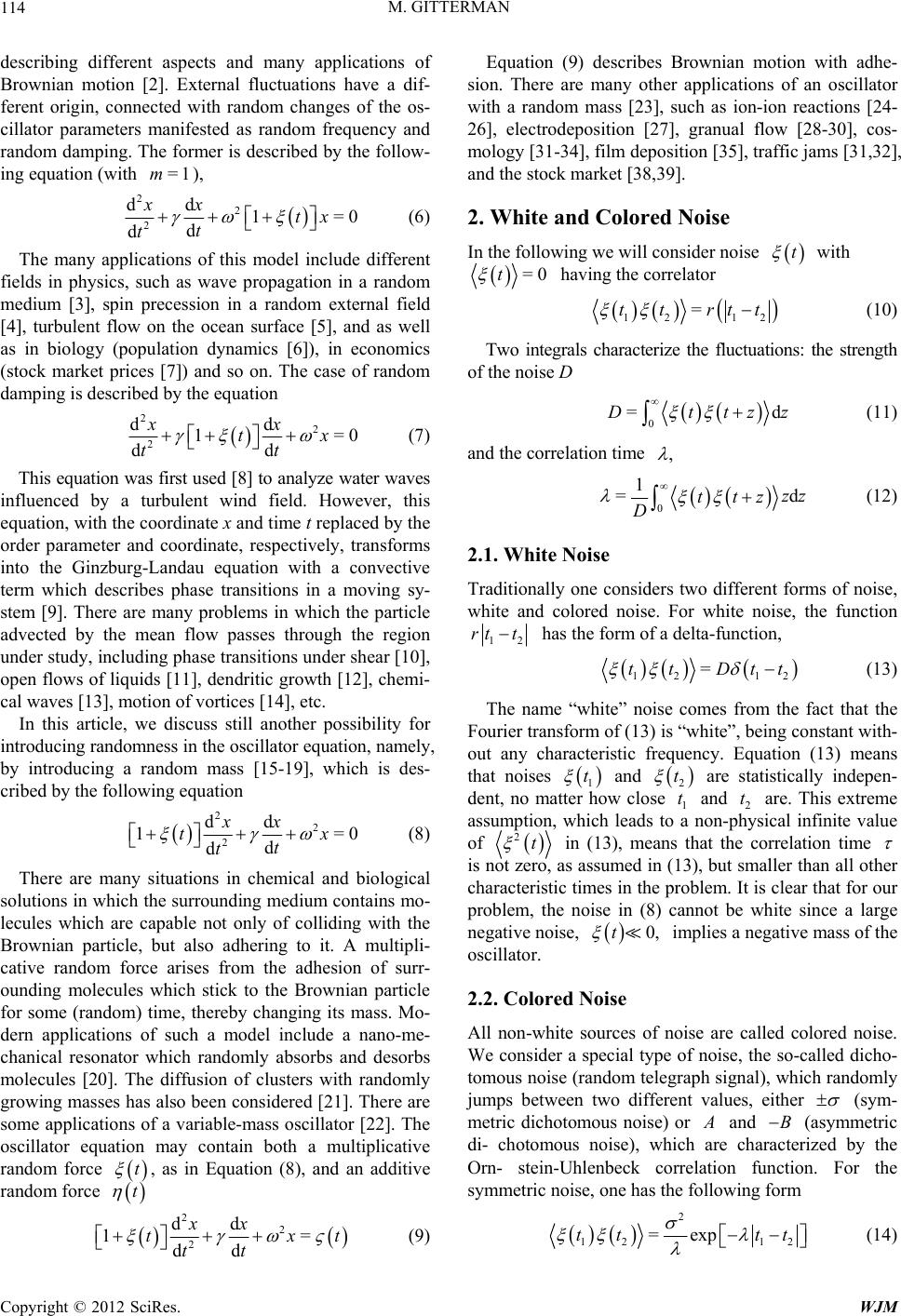 M. GITTERMAN 114 describing different aspects and many applications of Brownian motion [2]. External fluctuations have a dif- ferent origin, connected with random changes of the os- cillator parameters manifested as random frequency and random damping. The former is described by the follow- ing equation (with =1m), 2 d2 d1=0 dtx t (6) The many appliof this model include different fie 2d xx t cations lds in physics, such as wave propagation in a random medium [3], spin precession in a random external field [4], turbulent flow on the ocean surface [5], and as well as in biology (population dynamics [6]), in economics (stock market prices [7]) and so on. The case of random damping is described by the equation 2 ddxx 2 1= 0 d dtx t (7) This equation was fi used [8] to analyze water waves in ssibility for in 2 t rst fluenced by a turbulent wind field. However, this equation, with the coordinate x and time t replaced by the order parameter and coordinate, respectively, transforms into the Ginzburg-Landau equation with a convective term which describes phase transitions in a moving sy- stem [9]. There are many problems in which the particle advected by the mean flow passes through the region under study, including phase transitions under shear [10], open flows of liquids [11], dendritic growth [12], chemi- cal waves [13], motion of vortices [14], etc. In this article, we discuss still another po troducing randomness in the oscillator equation, namely, by introducing a random mass [15-19], which is des- cribed by the following equation 2 dx2 2 d 1=0 d d x tx t t (8) There are ma in chemical and biological so ny situations lutions in which the surrounding medium contains mo- lecules which are capable not only of colliding with the Brownian particle, but also adhering to it. A multipli- cative random force arises from the adhesion of surr- ounding molecules which stick to the Brownian particle for some (random) time, thereby changing its mass. Mo- dern applications of such a model include a nano-me- chanical resonator which randomly absorbs and desorbs molecules [20]. The diffusion of clusters with randomly growing masses has also been considered [21]. There are some applications of a variable-mass oscillator [22]. The oscillator equation may contain both a multiplicative random force t , as in Equation (8), and an additive random force t 2 2 2 dd 1 d d xx tx t t = t (9) Equation (9) describes Brownian motion wi sion. There are many other applications of an wi In the following we will consider noise th adhe- oscillator th a random mass [23], such as ion-ion reactions [24- 26], electrodeposition [27], granual flow [28-30], cos- mology [31-34], film deposition [35], traffic jams [31,32], and the stock market [38,39]. 2. White and Colored Noise t with =0t having the correlator 12 12 =tt rtt ls characterize the fluc (10) Two integratuations: the strength of the noise D 0 =dDzttz (11) and the correlation time , 0 1 =dzz ttz D (12) 2.1. White Noise Traditionally one considers two different forms of noise, . For white noise, the function white and colored noise 12 rt t has the form of a delta-function, 12 12 =tt Dtt (13) e “white” noise comes from the The namfact that the Fourier transform of (13) is “white”, being c out onstant with- any characteristic frequency. Equation (13) means that noises 1 t and 2 t are statistically indepen- dent, no matter how close 1 t and 2 t are. This extreme assumption, which leads to a non-physical infinite value of 2t in (13), means that the correlation time is not zero, as assumed in (13), but smaller than all other characteristic times in the problem. It is clear that for our problem, the noise in (8) cannot be white since a large negative noise, 0,t implies a negative mass of the oscillator. 2.2. Colored Noise All non-white sources of noise are called colored noise. type of noise, the so-called dicho- We consider a special tomous noise (random telegraph signal), which randomly jumps between two different values, either (sym- metric dichotomous noise) or and B (asymmetric di- chotomous noise), which are characterized by the Orn- stein-Uhlenbeck correlation function. For the symmetric noise, one has the following form 2 12 12 =exptt tt (14) Copyright © 2012 SciRes. WJM  M. GITTERMAN 115 White noise (13) is defined by its strength Ornstein-Uhlenbeck noise is characterized ram D while the by two pa- eters, 2 and . The transition from the Ornstein- Uhlenbeck noise (14) to white noise (13) occurs in the limit 2 and , with 2=D in (14). Returning to our Equation (8) and multiplying it by 1,t one obtains 2 22 2 dd 11 =0 d xtx t (15) dt Since the oscillator mass is positive, the condition should be satisfied in studies of Equatio 2<1 For the asym n (15). ptotic case of small oscillations of the mass, 21, Equation (15) can be rewritten as 2 22 2 dd d = dd d x tx tt t (16) Therefore, the small dichotomous fluctuations are equivalent to simultaneous fluctuations o que of mass f the fre- ncy and the damping coefficient. For asymmetric dichotomous noise, it is convenient to replace t in Equation (8) by a positive random force 2,t which corresponds to the fact that the mass of the Brownian particle can only increase due to the adhe- sion of the molecules of the surrounding medium, 2 22 2 dd 1= d d xx txt t t (17) The quadratic noise 2t can be written as 22 =t (18) with 2= B and .= B Indeed, for = , = one obtains = 22 BABA A , and for =,B 22 B = Then, Equation (17) takesllowing form, the fo 2 22 ddxx (19) Multiplying Equation (19) with 2= d d tx t t t 1 =0 by one obtains 2 1,t 2 22 dd d 1= d xx x Rx t 2 2d dx t t (20) where 2 2 22 =1 .R In the next two Sections we calculate two first ts, momen and 2 fuations (15) and (19) or Eq To split the correlations, we use the well-known Shapiro- Loginov procedure [40] which yields for exponentially correlated noise (14), dd = d g dd = dd g tt (22) and dd =d d n n n g t t (23) d g tt (21) or If dd= ,gt A Equation (21) becomes 2 d= d g t anr white noise ( (24) d fo2 and with 2=D ), one gets = D First M 3.1. White Noise Equation (8) can be rewritten in the following form (25) 3. oments 2 d2 2 2 d d = dd 2 d xx x tt (26) t Based on linear response theory, the output t of the system to the input 22 dd t is 2 0 1 d 1 =exp sin 2 tx tu u u 12d d xt u tt (27) where 22 1=4 . Finding 22 dd t from Eq ation (27), inserting it into Equation (26) and using the well-known formula for splitting the correlations, u- 2 dd = xx tt t 2 11 1 1 dd tt t tt (28) one obtains for white noise, 2 2 2 dd 1= d d Dxx x t t 0 tion of oscillator’s mass. 3.2. Symmetric Dichotomous Noise m (29) which means the renormaliza Averaging Equation (15) over an ensemble of rando functions t and using Equation (22) with = x leads to 2 22 2 dd 1d d x 2 d= d t t ) x t (30 where we assume white-noise correlations of noises Copyright © 2012 SciRes. WJM 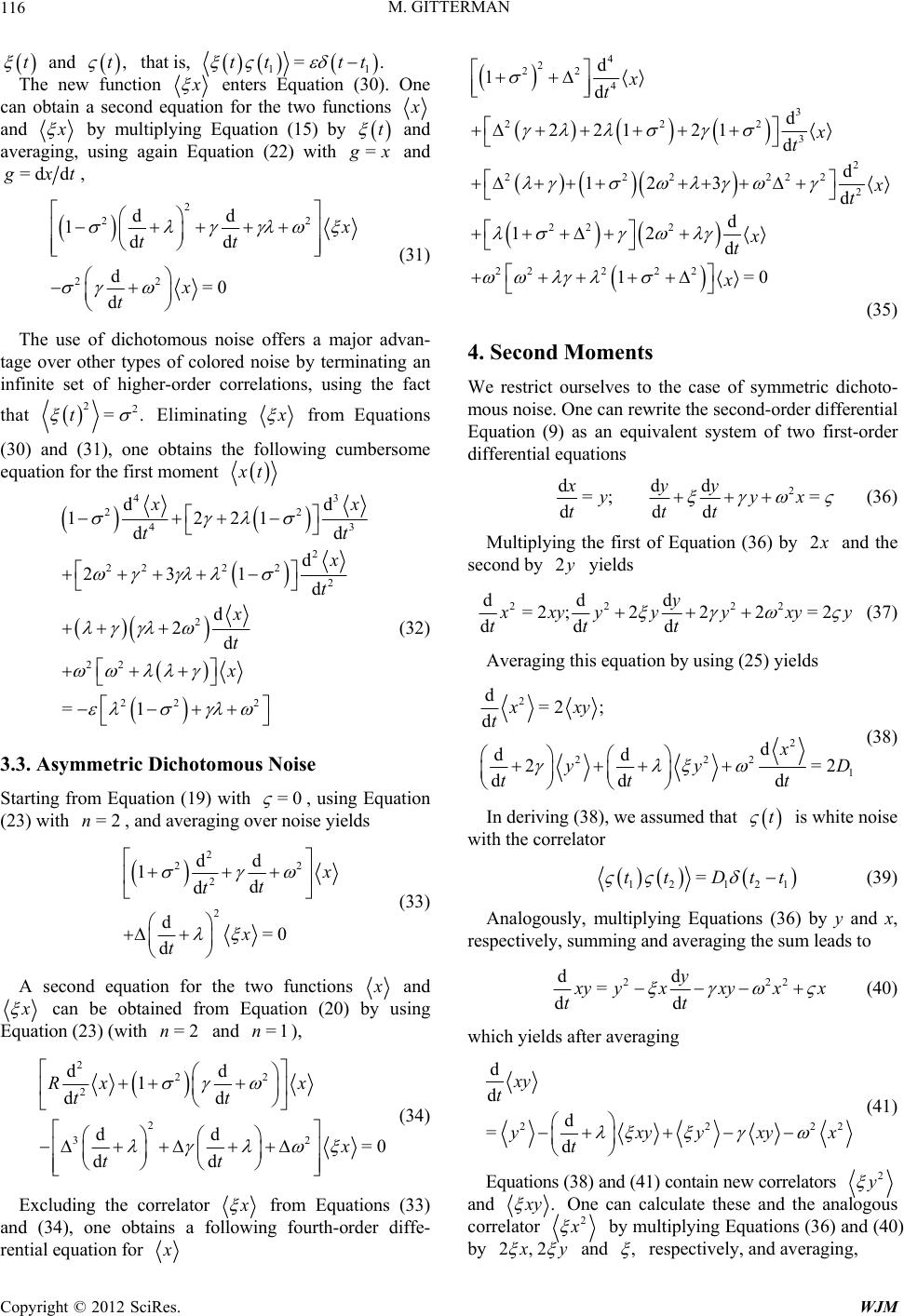 M. GITTERMAN 116 t and that is, ,t 11 =.tt tt The netion w func quatio enters Equation (30). One can obtain a second en for the two functions and by multiplying Equation (15) by t and averaging, using again Equation (22) with = x and =d d xt, 2 d 22 22 d 1dd d=0 d tt x t () 31 The use of dichotomous noise offers a major advan- tage over other types of colored noise by terminating an infinite set of higher-order correlations, using the that fact 22 =.t Eliminating from Eq (30) and (31), one obtains the following cumbersome eq uations uation for the first moment t 22 22 22 2 23 d =1 43 22 43 dd 1221 dd 2 22d 12 2 d d 2 x tt x t x t x (32) 3.3. Asymmetric Dichotomous Noise Starting from Equation (19) with =0 , using Equation (23) with and averaging ovse yields =2n,er noi 2 22 2 2 d dd 1d d =0 d t t (33) A second equation for the two functions x t and can be obtained from Equation (20) by using Equation (23) (with and =2n=1n), 2 22 2 2 32 dd =0 dd x tt ) dd 1d d Rx x t t (34 Excluding the correlator wing from Equations (33) and (34), one obtains a follo fourth-order diffe- rential equation for 4 2 22 4 3 222 3 2 222222 22222 d 1d d 22121d d 3 d 1=0 x t x t 2 22 2 12 d d 12 t x t x (35) 4. Second Moments We restrict ourselves to the case of symmetric dichoto mous noise. One can rewrite the second-order differential Equation (9) as an equivalent system of two first-order differential equations - 2 ddd =; = ddd xyy yy ttt x (36) Equation (36) by Multiplying the first of2 and the second by 2 yields 22 22 ddd =2 ;222=2 ddd y xy yyyxyy ttt (37) Averaging this equation by using (25) yields 2 2 222 d dd 2 dd x tt (38) 1 d=2 ; d =2 d xxy t yy D t In deriving (38), we assumed that t is white with the correlator noise =tt Dtt 12121 (39) Analogously, multiplying Equations (36) by y and x, respectively, summing and averaging the sum leads to 22 dd = dd y2 yyxxyx x tt (40) which yields after averaging 2222 d =d d dxy t xy yxyx t (41) Equations (38) and (41) contain new correlators 2 y . y and One can calculate these and the analogous correlator 2 by multiply by 2,2 ing Equations (36) and (40) y and , respectively, and averaging, Copyright © 2012 SciRes. WJM 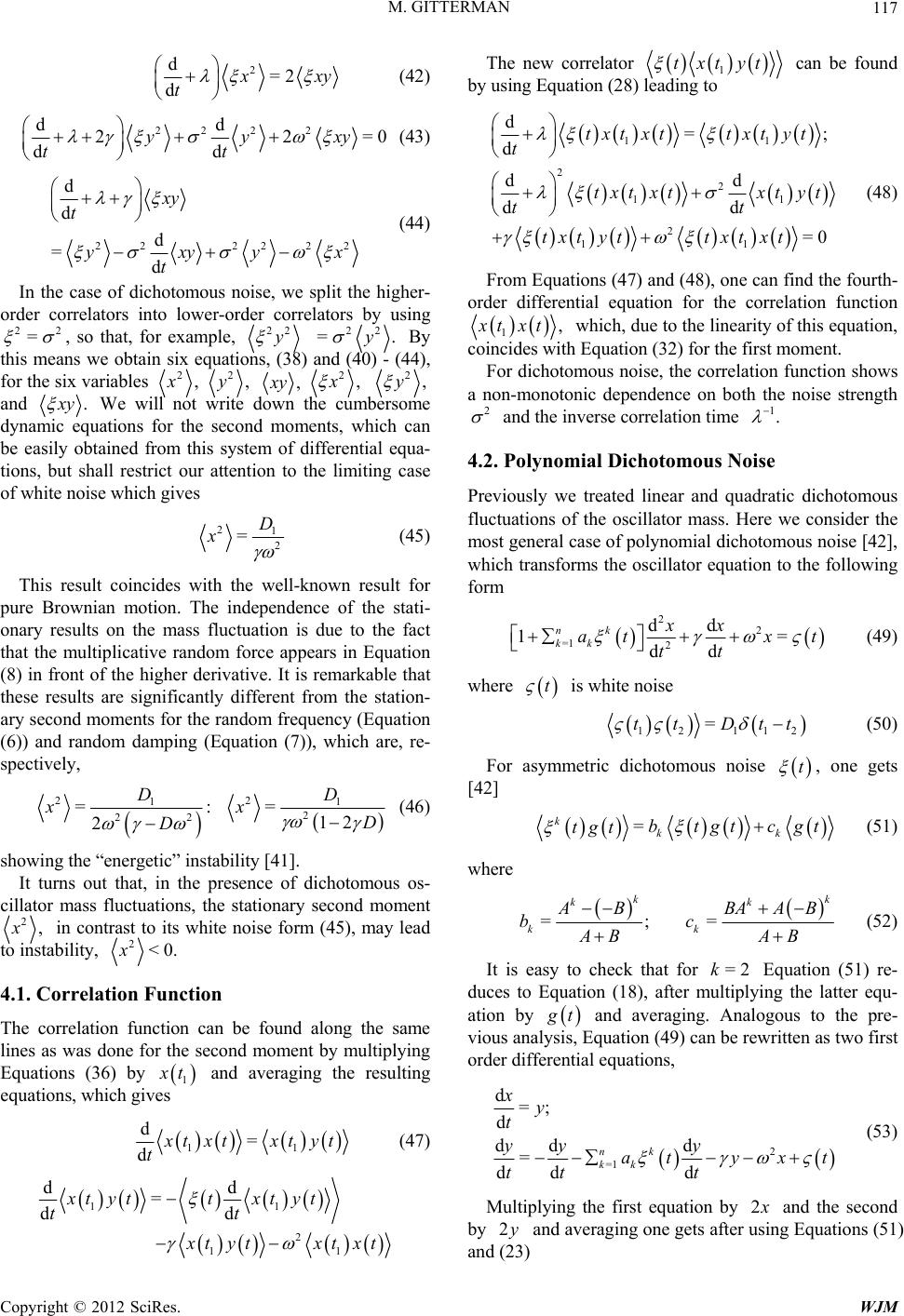 M. GITTERMAN 117 2 d=2 d xy t (42) 22 22 dd 22 dd yyxy tt =0 (43) 22 2222 d dxy t xyyx (44) d =d y t In the case of dichotomous noise, we spli order correlators into lower-order correlators by using t the higher- 22 = , so that, for example, 22 y 22 =.y By (44), this m for the six eans we obtain six equations, (38) and (40) - variables 2, 2,y , y 2, 2,y and . y namic equat We will not write down the cumbersome dyions for the second moments, w be easily obtained from this system of differential e tions, but shall restrict our attention to the limiting case of hich can qua- white noise which gives 21 =D x2 es the well-known own andom frequency (Equation (6)) and random damping (Equation spectively, (45) This result coincidwithresult for pure Brian motion. The independence of the stati- onary results on the mass fluctuation is due to the fact that the multiplicative random force appears in Equation (8) in front of the higher derivative. It is remarkable that these results are significantly different from the station- ary second moments for the r (7)), which are, re- 22 11 2 22 =:= 12 2 DD xx D D (46) showing the “energetic” instability [41]. It turns out that, in the presence of dichotomous os- cillator mass fluctuations, the stationary second moment 2, in contrast to its white noise form (45), may lead to instability, 2<0.x 4.1. Correlation Function The correlation function can be found along the lines as was done for the second moment by multiplying same Equations (36) by 1 t and averaging the resulting equations, which gives 11 d= d txt xtyt (47) t 1 dd = dd xt ytt t1 xt yt t 2 11 tytxtxt The new correlator 1 txtyt can be found by using Equation (28ding to ) lea 11 2 2 11 2 11 d=; d dd dd =0 txtxttxtyt t txt xtxt yt tt txtyttxtxt (48) nd (48), one can e correlation function From Equations (47) afind the fourth- order differential equation for th 1, txt which, due to the linearity of this equation, coincides with Equation (32) for the first moment. For dichotomous noise, the correlation function shows a non-monotonic dependence on both the noise strength 2 and the inverse correlation time 1. 4.2. Polynomial Dichotomous Noise Pr ost general owing eviously we treated linear and quadratic dichotomous fluctuations of the oscillator mass. Here we consider the m case of polynomial dichotomous noise [42], which transforms the oscillator equation to the foll form 2 =1 2 dd 1 d d nk kk xx at t t 2= x t (49) where t is white noise 11212 =Dtt tt (50) For asymmetric dichotomous noise t , one gets [42] = kkk bc tgt gt tgt (51) where =;= k kk k kk B bc BAAB BAB (52) It is easy to check that for Equation (51) re- du the by =2k ces to Equation (18), after multiplying latter equ- ation t and averaging. ogous to the pre- vious analysis, Equation (49) written as order differential equations, Anal can be retwo first 2 =1 dx=; d dd d = dd d nk kk y t yy y at yxt tt t (53) Multiplying the first equation by 2 and the second by 2 aneraging one gets after using Equations (51) and (23) d av Copyright © 2012 SciRes. WJM 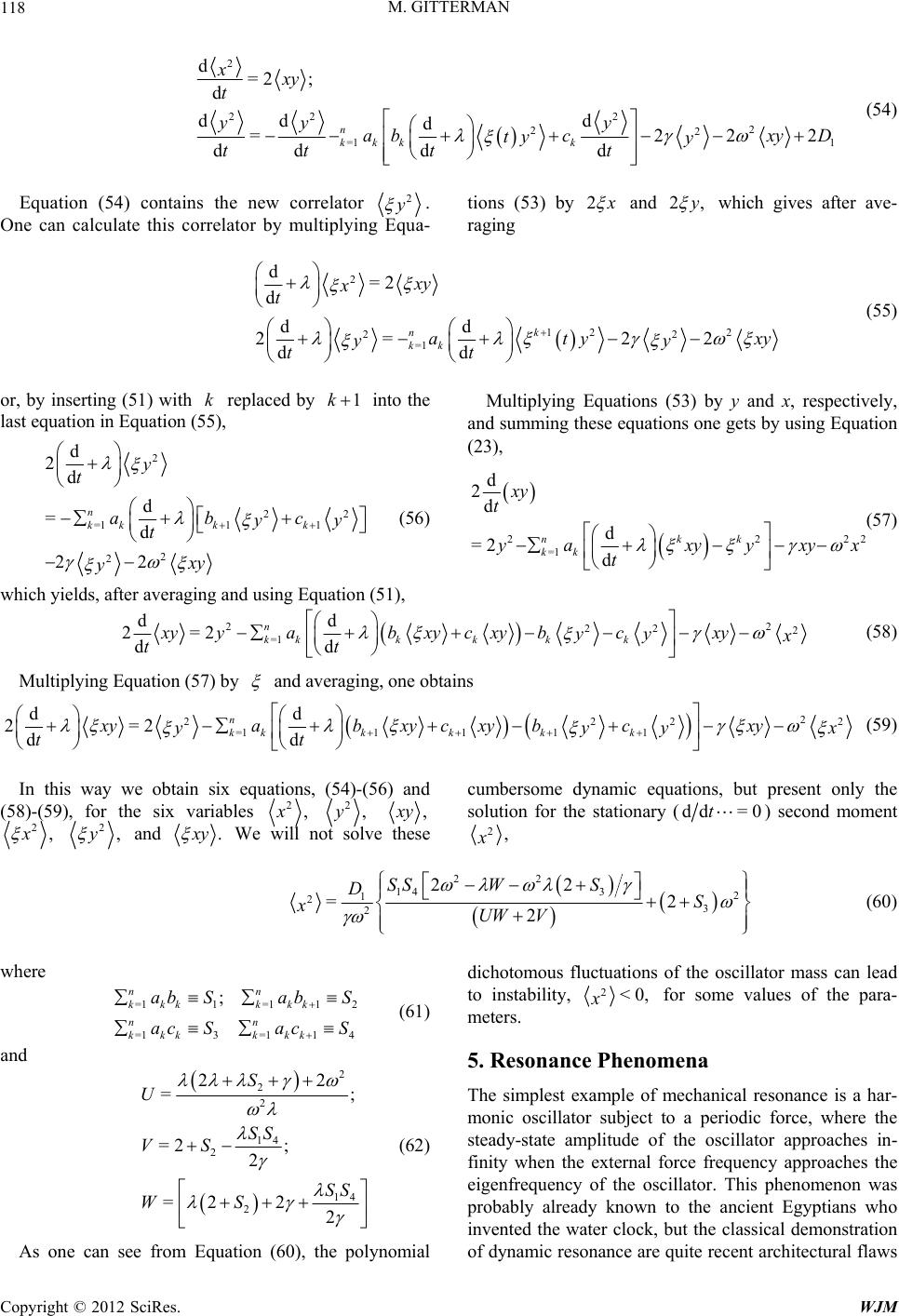 M. GITTERMAN Copyright © 2012 SciRes. WJM 118 2 d=2 ; d xxy 22 2 2 22 =1 1 dd d d =222 dd d n kk k t yy y ab cD xy ty y ttt (54) Equation (54) contains the new correlator d k t 2 . Equa- One can calculate this correlator by multiplying tions (53) by 2 and 2, which gives after ave- raging 2 2 12 22 =1 d=2 d dd 2= 22 dd nk kk xy x t a y ty yy tt (55) last equation in Equation (55), or, by inserting (51) with k replaced by 1k into the 2 22 =11 1 d 2d d =d n kkk k y t abc yy t (56) iplying Equations (53) by y and x, respectively, and summing these equations one gets by using Equation (23), Mult 22 =1 d 2d d =2 22nkk kk xy t ya xyyxyx dt (57) using Equation (51), 2 2 22 xy y which yields, after averaging and 2 2 22 2 =1 dd 2=2 dd n kkkk kk yab cbc xyxy xyxy yy tt (58) Multiplying Equation (57) by and averaging, one obtains 2 222 2 =11 111 dd 2=2 dd n kkk kkk abcbc xyxy xyxy yyy tt (59) In this way we obtain six equations, (54)-(56) and (58)-(59), for the six variables 2, 2,y , y 2, 2,y and . y W these e will not solve cumbersome dynamic equations, but prese solution for the stationary nt only the (dd =0t) second moment 2, 22 143 2 1 23 2 22 =2 2 SS WS DS xUW V and (60) where =1=11 2 nn kk kkk abab S (61) 1 =13=11 4 ; k nn kkk kkk S ac SacS 2 2 2 14 2 14 2 22 =; =2 ; 2 =22 2 S U SS VS SS WS (62) As one can see from Equation (60), the polynomial the oscilladichotomous fluctuations of tor mass can lead to instability, 2<0, x for sompara- s e values of the meter. 5. Resonance Phenomena The simplest example of mechanical resonance is a har- monic oscillator subject to a periodic force, where the steady-state amplitude of the oscillator approaches in- finity when the external force frequency approaches the eigenfrequency of the oscillator. This phenomenon was probably already known to the ancient Egyptians who invented the water clock, but the classical demonstration of dynamic resonance are quite recent architectural flaws 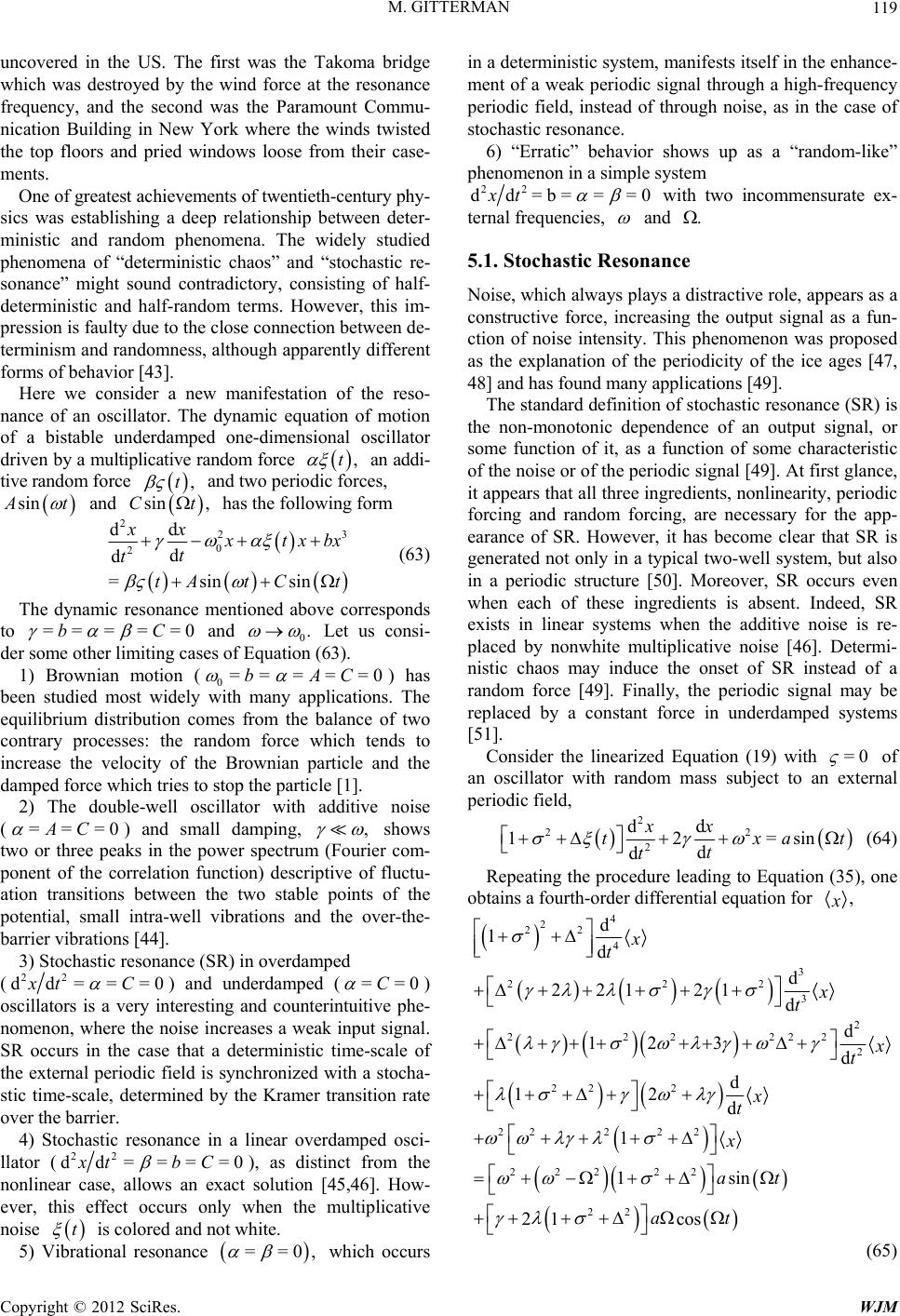 M. GITTERMAN 119 uncovered in the US. The first was the Takoma bridge which was destroyed by the wind force at the resonance frequency, and the second was the Paramount Commu- nication Building in New York where the winds the top floors and pried windows loose from their case- ments. One of greatest achievements of twentieth-century phy- sics was establishing a deep relationship between deter- m sound c istic and half-random terms. However, this im- pression is faulty due to the close connection between de- ugh apparently different twisted inistic and random phenomena. The widely studied phenomena of “deterministic chaos” and “stochastic re- sonance” mightontradictory, consisting of half- determin terminism and randomness, altho forms of behavior [43]. Here we consider a new manifestation of the reso- nance of an oscillator. The dynamic equation of motion of a bistable underdamped one-dimensional oscillator driven by a multiplicative random force ,t an addi- tive random force ,t and two periodic forces, sin t and sin ,Ct has the following form 2 23 0 2 dd d d =sinsin xx tx bx t t tA tCt (63) The dynamic resonance mentioned above corresponds to == == =0bC and 0. Let us consi- der some other limiting cases of Equation (63). 1) Brownian motion (0= = ===0bAC ) has been studied most widely with many applications. The equilibrium distribution comes from the balance of two contrary processes: the random force which tends to increase the velocity of the Brownian particle and the damped force which tries to stop the particle [1]. 2) The double-well oscillator with additive noise (===0AC ) and small damping, , shows two or three peaks in the power spectrum (Fourier com- ponent of the correlation function) descriptive of fluctu- at mped ion transitions between the two stable points of the potential, small intra-well vibrations and the over-the- barrier vibrations [44]. 3) Stochastic resonance (SR) in overda (22 dd==xt C nd underdamped (==C =0 ) a0 ) oscillators is a very interest nomenon, where the noise increases a weak input signal. SR occurs in the case that a deterministic tim the external periodic field is synchronized with a stocha- st ing and counterintuitive phe- e-scale of ic time-scale, determined by the Kramer transition rate over the barrier. 4) Stochastic resonance in a linear overdamped osci- llator (22 =0C), as distinct d d===xt b m the nonlinear case, allows an exact solution [45,46]. How- ever, this effect occurs only when the multiplicative noise t fro is colored and not white. 5) Vibrational resonance ==0, which occurs in a deterministic system, manifests itself in the enhance- ment of a weak periodic signal through a high-frequency pe ochastic reson riodic field, instead of through noise, as in the case of stance. 6) “Erratic” behavior shows up as a “random-like” phenomenon in a simple system 22 dd= b===0xt with two incommensurate ex- ternal frequencies, and . 5. d become c ation (19) with 1. Stochastic Resonance Noise, which always plays a distractive role, appears as a constructive force, increasing the output signal as a fun- ction of noise intensity. This phenomenon was proposed as the explanation of the periodicity of the ice ages [47, 48] and has found many applications [49]. The standard definition of stochastic resonance (SR) is the non-monotonic dependence of an output signal, or some function of it, as a function of some characteristic of the noise or of the periodic signal [49]. At first glance, it appears that all three ingredients, nonlinearity, periodic forcing an random forcing, are necessary for the app- eahas rance of SR. However, it lear that SR is generated not only in a typical two-well system, but also in a periodic structure [50]. Moreover, SR occurs even when each of these ingredients is absent. Indeed, SR exists in linear systems when the additive noise is re- placed by nonwhite multiplicative noise [46]. Determi- nistic chaos may induce the onset of SR instead of a random force [49]. Finally, the periodic signal may be replaced by a constant force in underdamped systems [51]. Consider the linearized Equ=0 of ss subject to an oscillator with random ma an external periodic field, 2 22 2 dd 12=sin d d xx txat t t (64) Repeating the procedure leading to Equation (35), one obtains a fourth-order differential equation for , 4 2 22 4 3 222 3 2 222222 2 22 2 22222 222 22 22 d 1d d 22121d d 12 3d d 12 d 1 1sin 21 cos x t x t t x t x at at (65) Copyright © 2012 SciRes. WJM 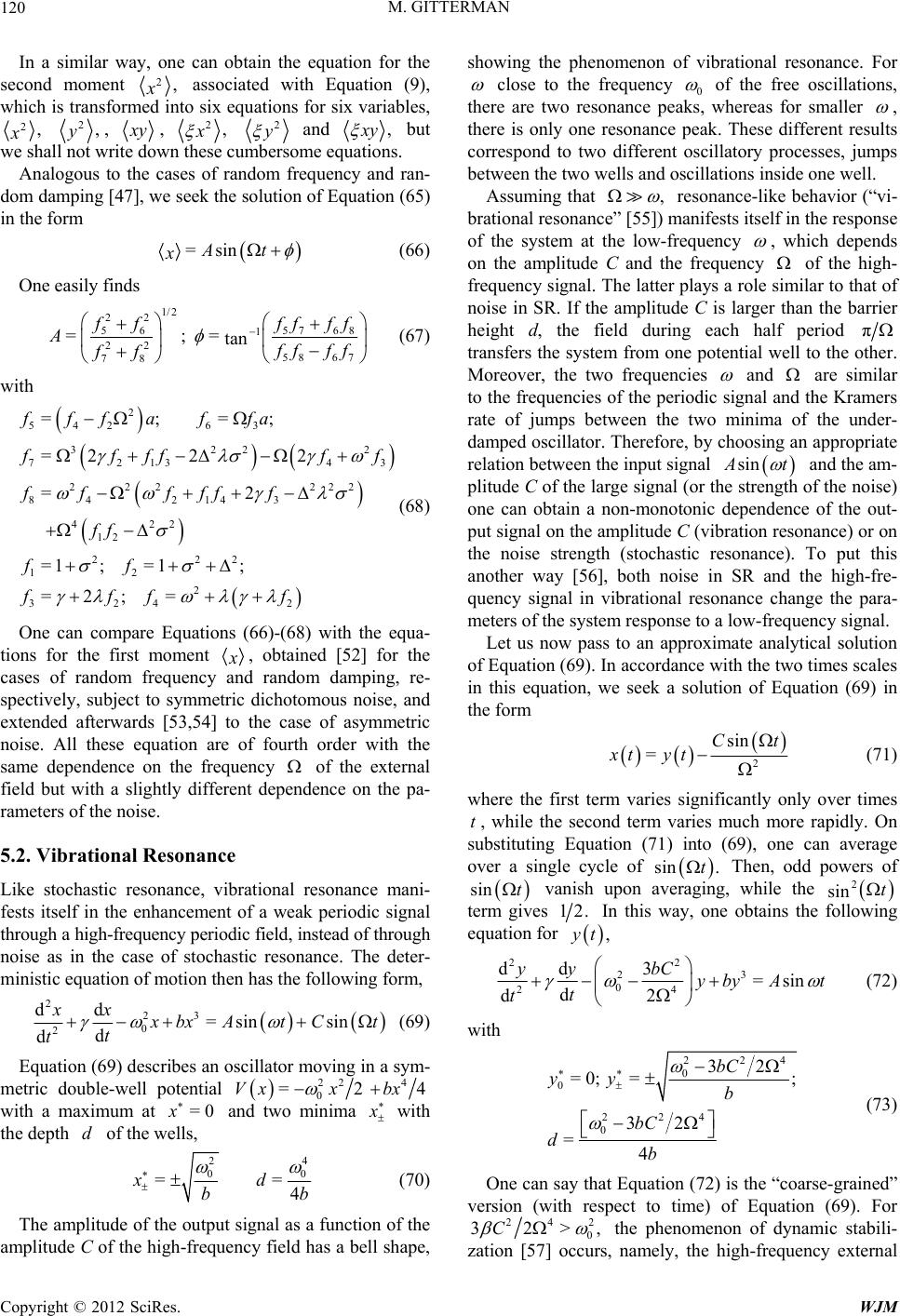 M. GITTERMAN 120 In a similar way, one can obtain the equation for the second moment 2, associated with Equation (9), which is transformed into six equations for six variables, 2, 2, , y, 2, 2 and , y but s. we shall not write down these cumbersome equation ti Analogous to the cases of random frequency and ran- dom damping [47], we seek the solution of Equaon (65) in the form =sinAt x (66) One easily finds 1/2 22 56 5768 1 22 58 67 78 =; = tan fff Aff fff ff (67) with 2 54263 322 7213 4 222222 84 2143 422 12 222 4 =;=; =2 22 =2 = fffaf fa 2 3 12 2 32 2 =1 ;=1; =2; ffff f ff ffff ff f ff ff f One can compare Equations (66)-(68) with the equa- tions for the first moment (68) , obtained [52] for the cases of random frequency and random damping, re- spectively, subject to symmetric dichotomous noise, and extended afterwards [53,54] to the case of asymmetric noise. All these equation are of fourth order with the same dependence on the frequency fie tly different dependence on the pa- ra 5.2. Vibrational Resonance stochastic resonance, vibrational resonance mani- tself in the enhancement of a weak periodic signal through a high-frequency periodic field, instead of through noise as in the case of stochastic resonance. The deter- ministic equation of motion then has the following form, of the external ld but with a sligh meters of the noise. Like fests i 2 23 0 2 dd =sin sin d d xx bxAt Ct t t (69) Equation (69) describes an oscillator moving in a sym- metric double-well potential 22 0 =2Vx x 44bx with a maximum at and two minima =0x with the depth d of the wells, 24 00 == 4 xd bb (70) The amplitude of the output signal as a function of the amplitude C of the high-frequency field has a bell shape, showing the phenomenon of vibrational resonance. For close to the frequency 0 of the free oscillations, there are two resonance peaks, whereas for smaller , there is only one resonance peak. These different results correspond to two different oscillatory processes, jumps tions inside one well. between the two wells and oscilla Assuming that , resonance-like behavior (“vi- brational resonance” [55]) manifests itself in the response of the system at the low-frequency , which depends on the amplitude C and the frequency of the high- frequency signal. The latter plays a role similar to that of noise in SR. If the amplitude C is larger than the barrier height d, theperiod field during each half π other. transfers the syste one to the M m frompotential well oreover, the two frequencies and are similar to the frequencies of the period rate of jumps betweetwo minima of the under- damped osllator. Therefore by choosing an appropriate relation beteen the input si ithe Kramers e ci , wgnal c signal a sin nd n th t and the am- plitude C of thor t one can obtain a non-monotonic depende pu e large signal (he strength of the noise) nce of the out- t signal on the amplitude C (vibration resonance) or on the noise strength (stochastic resonance). To put this another way [56], both noise in SR and the high-fre- quency signal in vibrational resonance change the para- meters of the system response to a low-frequency signal. Let us now pass to an approximate analytical solution of Equation (69). In accordance with the two times scales in this equation, we seek a solution of Equation (69) in the form 2 sin =Ct xt yt (71) where the first term varies significantly only over times t, while the second term varies much more rapidly. On substituting Equation (71) into (69), one can average over a single cycle of sin .t Then, odd powers of sint vanish upon averaging, while the 2 sin t term gives 12. In this way, one obtains the following equation for , t 22 23 0 24 dd 3n d d2 yy bC y t t t=siby A (72) with 224 0 0 224 0 32 =0; =; 32 =4 bC yy b bC db (73) One can say that Equation (72) is the “coarse-grained” version (with respect to time) of Equation (69). For 242 32>,C0 the phenomenon of dynamic stabili- zation [57] occurs, namely, the high-frequency external Copyright © 2012 SciRes. WJM 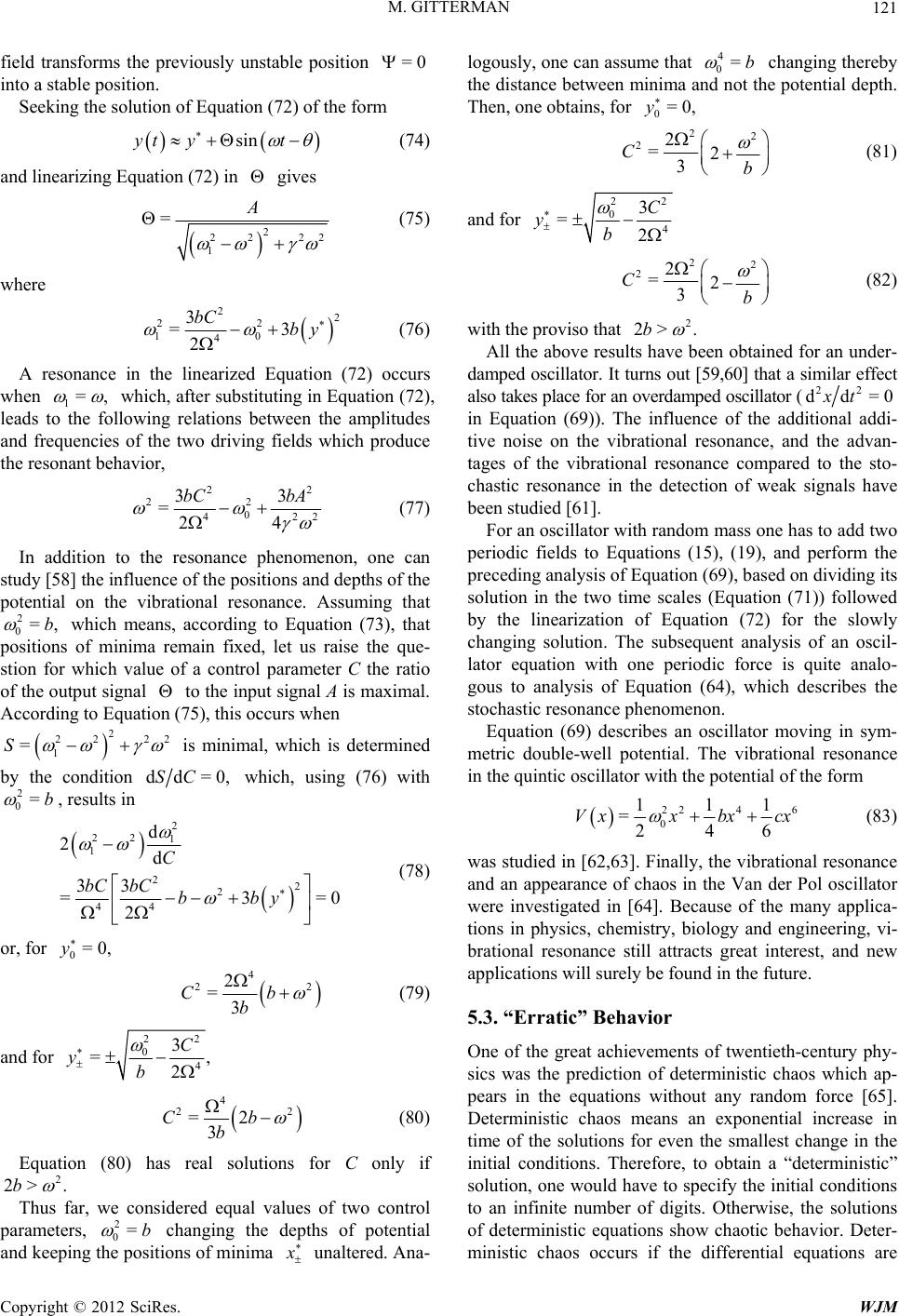 M. GITTERMAN 121 field transforms the previously unstable position =0 into a stable position. Seeking the solution of Equation (72) of the form sinyt yt (74) and linearizing Equation (72) gives in 2 22 22 1 =A (75) where 22 22 10 4 3 =3 2 bC by A resonance in the linearized Equation (72) when (76) occurs 1=, h which, after substituting in leads to te following relations between th and frequencies of the two driving fields w the resonant behavior, Equation (72), e amplitudes hich produce 22 22 0 422 33 =24 bC bA (77) In addition to the resonance phenomenon, one can study [58] the influence of the positions and depths of the potential on the vibrational resonance. Assuming that 2=,b which means 0, according to Equation (73), sitions of minima remain fixed, let us raise the q that ue- maximal. po stion for of the out which value of a control parame put signal to the input signal A is ocn 2 ter C the ratio According to Equation (75), this curs whe 2 22 2 1 =S is minimal, which by the condition is determined dd=0,SC which, using (76) , results in with 2=b 0 2 22 1 1 22 2 44 =3 =0 2bby or, for 0=0,y d 2d 33 C bC bC (78) 4 22 2 Cb=3b and for (79) 22 0 4 3 =, 2 C yb 4 22 =2 3 Cb b (80) tion (80) has real solutions for C only if 2 2> .bEqua Thus far, we considered equal values of two control parameters, 2 0=b hanging the depths of potential and keeping the positions of minima c unaltere logously, one can assu the distance between m or d. Ana- me that 4 0=b changing thereby inima and not the potential depth. Then, one obtains, f 0=0y, 22 22 =2 3 Cb (81) and for 22 0 4 3 =2 C yb 22 22 =2 3 Cb (82) with the proviso that 2 2> .b lts have beAll the above resuen obtained for an under- oscillator. It turns out [59,60] that a similar effect s place for an overdaped oscillator damped also takem(22 dd=0xt ditional addi- in Equation (69)). The influence of the ad tive noise on the vibrational resonance tages of the vibrational resonance compared to the sto- ch been studd [61]. to E (Equat subsequent analysis of an oscil- lator equation with one periodic force is quite analo- gous to analysis of Equation (64), wh stochastic resonance phenomenon. Equation (69) describes an oscillator moving in sym- ouble-well potential. The vibrational resonance in the quintic oscillator with the potential of the form , and the advan- astic resonance in the detection of weak signals have ie For an oscillator with random mass one has to add two periodic fieldsquations (15), (19), and perform the preceding analysis of Equation (69), based on dividing its solution in the two time scalesion (71)) followed by the linearization of Equation (72) for the slowly changing solution. The ich describes the metric d 224 6 cx (83) 0 111 =246 Vxx bx ]. Finally, the vibrational resonance neering, vi rential equations are was studied in [62,63 and an appearance of chaos in the Van der Pol oscillator were investigated in [64]. Because of the many applica- tions in physics, chemistry, biology and engi- brational resonance still attracts great interest, and new applications will surely be found in the future. 5.3. “Erratic” Behavior One of the great achievements of twentieth-century phy- sics was the prediction of deterministic chaos which ap- pears in the equations without any random force [65]. Deterministic chaos means an exponential increase in time of the solutions for even the smallest change in the initial conditions. Therefore, to obtain a “deterministic” solution, one would have to specify the initial conditions to an infinite number of digits. Otherwise, the solutions of deterministic equations show chaotic behavior. Deter- ministic chaos occurs if the diffe Copyright © 2012 SciRes. WJM 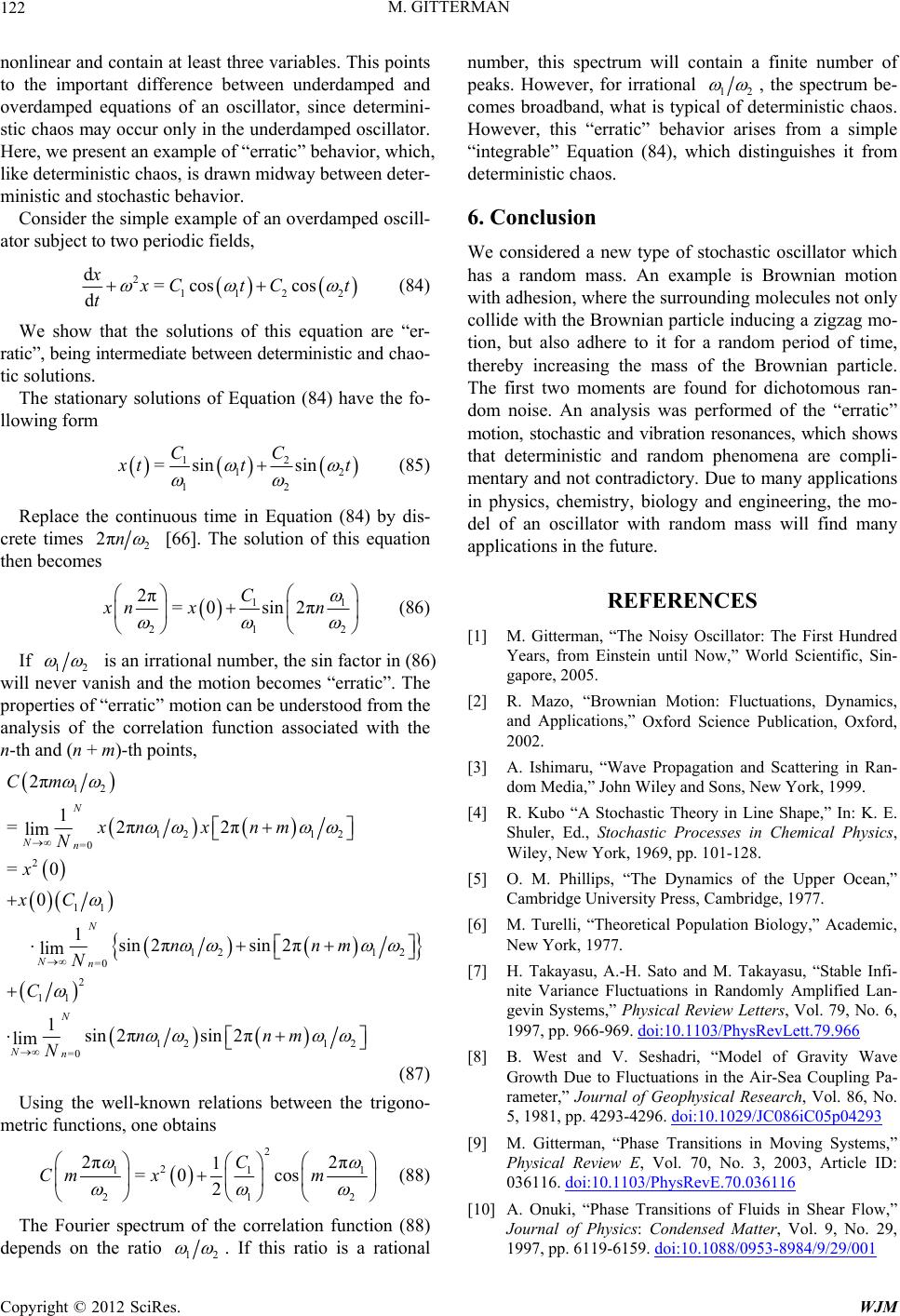 M. GITTERMAN 122 no ini- stic chaos may occur only in the underdamped oscillator. Here, we present an example of “erratic” be like deterministic chaos, is drawn midway between deter- nlinear and contain at least three variables. This points to the important difference between underdamped and overdamped equations of an oscillator, since determ havior, which, ministic and stochastic behavior. Consider the simple example of an overdamped oscill- ator subject to two periodic fields, 2 1122 d=cos cos d x CtC t t (84) We show that the solution ratic”, being intermediate bet s of this equation are “er- ween deterministic and chao- tic solutions. The stationary solutions of Equation (84) have the fo- llowing form 12 12 12 =sin sin CC ttt (85) Replace the continuous time in Equation (84) by dis- crete times 2 2πn [66]. The solution of this equation then becomes 11 212 2π=0sin2π C xn xn (86) If 12 is an irrational number, the sin factor in (86) will never vanish and the motion becomes “erratic”. The properties of “erratic” motion can be understood from the analysis of the correlation function associated with the n-th and (n + m)-th points, 12 2πCm 12 12 =0 2 11 1 =2π2π lim = 1sin2πsin 2π lim N Nn N N xn x nm N C nnm ell-known relations between the trigono- metric functions, one obtains 2 11 0 0 N x xC 12 12 =0 1sin2πsin 2π lim Nnnn m N 12 12 =0n N (87) Using the w 2 2 111 2π2π 1 =0 cos C Cm xm 21 2 2 The Fourier spectrum of the correlation function (88) depends on the ratio (88) 12 . If this ratio is a rational number, this spectrum will contain a finite number of peaks. However, for irrational 12 pical of de havior ar hich di chastic ple is B unding m rticle indu random the B und for rforme , the spectrum be- comes broadband, what is tyterministic chaos. However, this “erratic” beises from a simple “integrable” Equation (84), wstinguishes it from deterministic chaos. 6. Conclusion We considered a new type of stooscillator which has a random mass. An examrownian motion with adhesion, where the surroolecules not only collide with the Brownian pacing a zigzag mo- tion, but also adhere to it for a period of time, thereby increasing the mass ofrownian particle. The first two moments are fodichotomous ran- dom noise. An analysis was ped of the “err m phenomena are compli- mentary and not contradictory. Due to many applications in physics, chemistry, biology and engineering, t del of an oscillator with random mass will find ap Oxford Science Publication, Oxford, Wave Propagation and Scattering in Ran- atic” otion, stochastic and vibration resonances, which shows that deterministic and random he mo- many plications in the future. REFERENCES [1] M. Gitterman, “The Noisy Oscillator: The First Hundred Years, from Einstein until Now,” World Scientific, Sin- gapore, 2005. [2] R. Mazo, “Brownian Motion: Fluctuations, Dynamics, and Applications,” 2002. [3] A. Ishimaru, “ dom Media,” John Wiley and Sons, New York, 1999. [4] R. Kubo “A Stochastic Theory in Line Shape,” In: K. E. Shuler, Ed., Stochastic Processes in Chemical Physics, Wiley, New York, 1969, pp. 101-128. [5] O. M. Phillips, “The Dynamics of the Upper Ocean,” Cambridge University Press, Cambridge, 1977. [6] M. Turelli, “Theoretical Population Biology,” Academic, New York, 1977. [7] H. Takayasu, A.-H. Sato and M. Takayasu, “Stable Infi- nite Variance Fluctuations in Randomly Amplified Lan- gevin Systems,” Physical Review Letters, Vol. 79, No. 6, 1997, pp. 966-969. doi:10.1103/PhysRevLett.79.966 [8] B. West and V. Seshadri, “Model of Gravity Wave Growth Due to Fluctuations in the Air-Sea Coupling Pa- rameter,” Journal of Geophysical Research, Vol. 86, No. 5, 1981, pp. 4293-4296. doi:10.1029/JC086iC05p04293 [9] M. GittermanMoving Systems,” , “Phase Transitions in Physical Review E, Vol. 70, No. 3, 2003, Article ID: 036116. doi:10.1103/PhysRevE.70.036116 [10] A. Onuki, “Phase Transitions of Fluids in Shear Flow,” Journal of Physics: Condensed Matter, Vol. 9, No. 29, 1997, pp. 6119-6159. doi:10.1088/0953-8984/9/29/001 Copyright © 2012 SciRes. WJM  M. GITTERMAN 123 [11] J. M. Chomaz and A. Couairon, “Against the Wind,” Physics of Fluids, Vol. 11, No. 10, 1999, pp. 2977-2984. doi:10.1063/1.870157 [12] F. Hestol and A. Libchaber, “Unidirectional Crysta rtex Matter Driven by Bias Current,” l Growth and Crystal Anisotropy,” Physica Scripta, Vol. 1985, No. 9, 1985, pp. 126-129. [13] A. Saul and K. Showalter, “Propagating Reaction Diffu- sion Fronts,” In: R. J. Field and M. Burger, Eds., Oscilla- tions and Traveling Waves in Chemical Systems, Wiley, New York, 1985, pp. 419-439. [14] M. Gitterrman, B. Ya. Shapiro and I. Shapiro, “Phase Transitions in Vo Physical Review B, Vol. 65, No. 17, 2002, Article ID: 174510. doi:10.1103/PhysRevB.65.174510 [15] M. Gitterman, “New Stochastic Equation for a Harmonic Oscillator: Brownian Motion with Adhesion,” Journal o . , Article ID: f Physics C: Conference Series, Vol. 248, No. 1, 2010, Ar- ticle ID: 012049. [16] M. Gitterman “New Type of Brownian Motion,” Journal of Statistical Physics, Vol. 146, No. 1, 2010, pp. 239-243 [17] M. Gitterman and V. I. Kljatskin, “Brownian Motion with Adhesion: Harmonic Oscillator with Fluctuating Mass,” Physical Review E, Vol. 81, No. 5, 2010 051139. [18] M. Gitterman and I. Shapiro, “Stochastic Resonance in a Harmonic Oscillator with Random Mass Subject to Asymmetric Dichotomous Noise” Journal of Statistical Physics, Vol. 144, No. 1, 2011, pp. 139-149. [19] M. Gitterman “Harmonic Oscillator with Fluctuating Mass,” Journal of Modern Physics, Vol. 2, 2010, pp. 1136-1140. [20] J. Portman, M. Khasin, S. W. Shaw and M. I. Dykman, “The Spectrum of an Oscillator with Fluctuating Mass and Nanomechanical Mass Sensing,” Bulletin of the American Physical Society March Meeting, Portland, 15-19 March 2010. [21] J. Luczka, P. Hanggi and A. Gadomski, “Diffusion of Clusters with Randomly Growing Masses,” Physical Re- view E, Vol. 51, No. 6, 1995, pp. 5762-5769. doi:10.1103/PhysRevE.51.5762 [22] M. S. Abdalla, “Time-Dependent Harmonic Oscillator with Variable Mass under the Action of a Driving Force,” Physical Review A, Vol. 34, No. 6, 1986, pp. 4598-4605. doi:10.1103/PhysRevA.34.4598 [23] R. Lambiotte and M. Ausloos, “Brownian Particle Having a Fluctuating Mass,” Physical Review E, Vol. 73, No. 1, 2005, Article ID: 011105. [24] A. Gadomski and J. Siódmiak, “A Kinetic Model of Pro- tein Crystal Growth in Mass Convection Regime” Crystal Research and Technology, Vol. 37, No. 2-3, 2002, pp. 281-291. doi:10.1002/1521-4079(200202)37:2/3<281::AID-CRAT 281>3.3.CO;2-4 [25] M. Rub and A. Gadomski, “Nonequilibrium Thermody- namics versus Model Grain Growth: Derivation and Some Physical Implication,” Physica A, Vol. 326, No. 3-4, 2003, pp. 333-343. doi:10.1016/S0378-4371(03)00282-6 [26] A. Gadomski, J. Siódmiak, I. Santamara-Holek, J. M lle and C. Soria, “Modeling the Elec- . Rub and M. Ausloos, “Kinetics of Growth Process Con- trolled by Mass-Convective Fluctuations and Finite-Size Curvature Effects,” Acta Physica Polonica B, Vol. 36, No. 5, 2005, pp. 1537-1559. [27] A. T. Pérez, D. Savi trophoretic Deposition of Colloidal Particles,” Europhy- sics Letters, Vol. 55, No. 3, 2001, pp. 425-431. doi:10.1209/epl/i2001-00431-5 [28] I. Goldhirsch and G. Zanetti, “Clustering Instability in Dissipative Gases,” Physical Review Letters, Vol. 70, No. 11, 1993, pp. 1619-1622. doi:10.1103/PhysRevLett.70.1619 [29] S. Luding and H. J. Herrmann, “Cluster-Growth in Freely Cooling Granular Media,” Chaos, Vol. 9, No. 3, 1999, pp. 673-682. doi:10.1063/1.166441 I. Temizer, “A Computatio[30] nal Model for Aggregation in a Class of Granual Materials,” Master Thesis, University of California, Berkeley, 2001. [31] W. Benz, “From Dust to Planets,” Spatium, Vol. 6, 2000, pp. 3-15. [32] J. Blum, et al., “Growth and Form of Planetary Seedlings: Results from a Microgravity Aggregation Experiment,” Physical Review Letters, Vol. 85, No. 12, 2000, pp. 2426- 2429. [33] J. Blum and G. Wurm, “Experiments on Sticking, Re- structuring and Fragmentation of Preplanetary Dust Ag- gregates,” Icarus, Vol. 143, No. 1, 2000, pp. 138-146. doi:10.1006/icar.1999.6234 [34] S. J. Weidenschilling, D. Spaute, D. R. Davis, F. Marzari and K. Ohtsuki, “Accretional Evolution of a Planetesimal Swarm,” Icarus, Vol. 128, No. 2, 1997, pp. 429-455. doi:10.1006/icar.1997.5747 [35] N. Kaiser, “Review of the Fundamentals of T Growth,” Applied Optics, Vol. hin-Film 41, No. 16, 2002, pp. 3053-3060. doi:10.1364/AO.41.003053 [36] T. Nagatani, “Kinetics of Clustering and Acceleration in 1D Traffic Flow,” Journal o 65, 1996, pp. 3386-3389. f Physical Society Japan, Vol. 3/JPSJ.65.3386doi:10.114 [37] E. Ben-Naim, P. L. Krapivsky and S. Redner, “Kinetics of Clustering in Traffic Flows,” Physical Review E, Vol. 50, No. 2, 1994, pp. 822-829. doi:10.1103/PhysRevE.50.822 [38] M. Ausloos and K. Ivanova, “Mechanistic Approach to Generalized Technical Analysis of Share Prices and Stock 2, pp. 177-187. Market Indices,” European Journal of Physics B, Vol. 27, No. 4, 200 doi:10.1007/s10051-002-9018-9 [39] M. Ausloos and K. Ivanova, “Generalized Technical Analysis. Effects of Transaction Volume and Risk,” In: H. Takayasu, Ed., The Applications of Econophysics, Sprin- ,” . 563-574. ger Verlag, Berlin, 2004, pp. 117-124. [40] V. E. Shapiro and V. M. Loginov, “Formulae of Differen- tiation” and Their Use for Solving Stochastic Equations Physica A, Vol. 91, 1978, pp [41] M. Gitterman, “Classical Harmonic Oscillator with Mul- tiplicative Noise,” Physica A, Vol. 352, No. 2-4, 2005, pp. 309-334. doi:10.1016/j.physa.2005.01.008 Copyright © 2012 SciRes. WJM 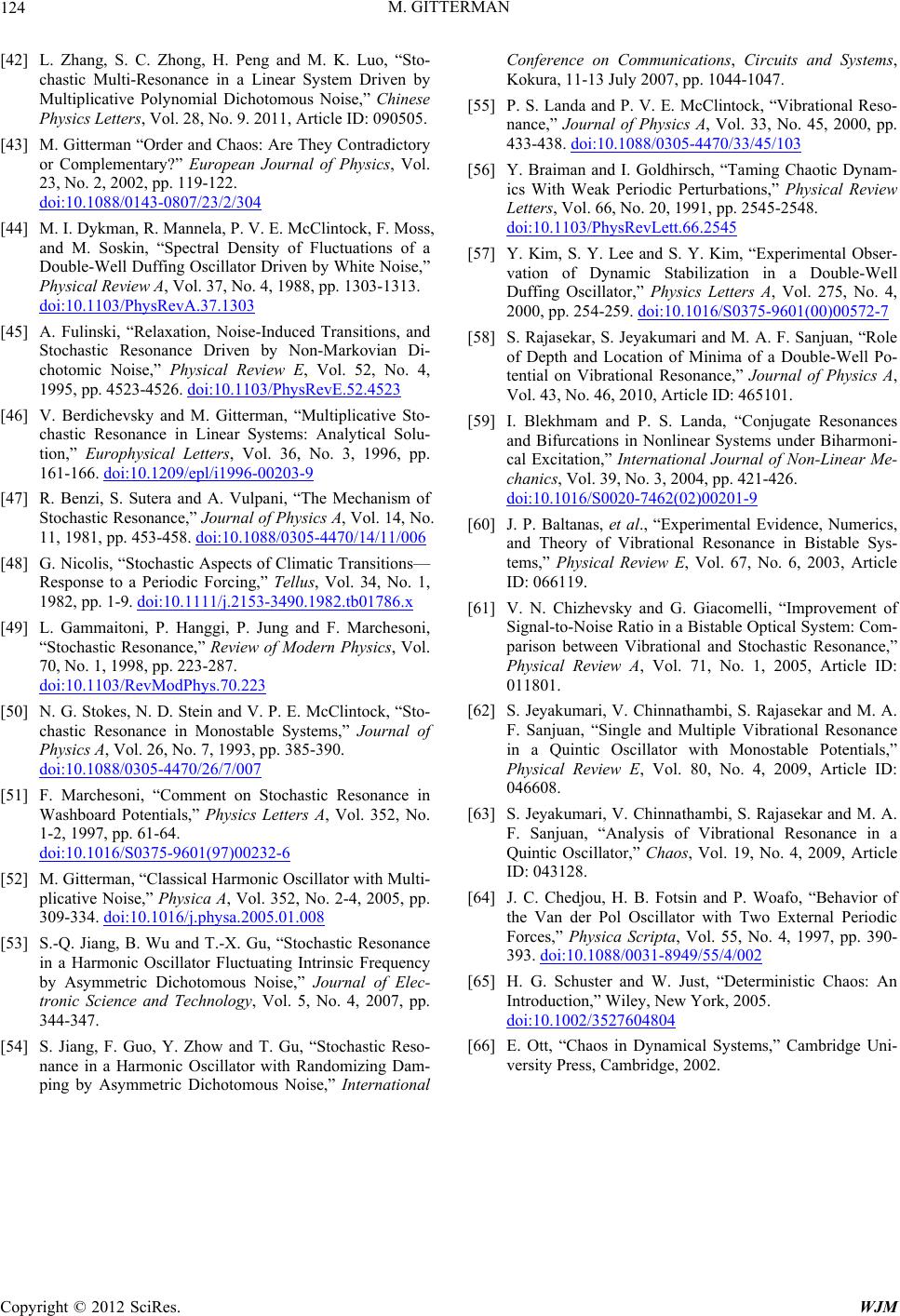 M. GITTERMAN Copyright © 2012 SciRes. WJM 124 Peng and M. K. Luo, “Sto-[42] L. Zhang, S. C. Zhong, H. chastic Multi-Resonance in a Linear System Driven by Multiplicative Polynomial Dichotomous Noise,” Chinese Physics Letters, Vol. 28, No. 9. 2011, Article ID: 090505. [43] M. Gitterman “Order and Chaos: Are They Contradictory or Complementary?” European Journal of Physics, Vol. 23, No. 2, 2002, pp. 119-122. doi:10.1088/0143-0807/23/2/304 [44] M. I. Dykman, R. Mannela, P. V. E. McClintock, F. Moss, and M. Soskin, “Spectral Density of Fluctuations of a Double-Well Duffing Oscillator Physical Review A, Vol. 37, No. Driven by White Noise,” 4, 1988, pp. 1303-1313. doi:10.1103/PhysRevA.37.1303 [45] A. Fulinski, “Relaxation, Noise-Induced Transitions, and Stochastic Resonance Driven by Non-Markovian Di- chotomic Noise,” Physical Revi 1995, pp. 4523-4526. ew E, Vol. 52, No. 4, ysRevE.52.4523 doi:10.1103/Ph [46] V. Berdichevsky and M. Gitterman, “Multiplicative Sto- chastic Resonance in Linear Systems: Analytical Solu- tion,” Europhysical Letters, Vol. 36, No. 3, 1996, pp. 161-166. doi:10.1209/epl/i1996-00203-9 -4470/14/11/006 [47] R. Benzi, S. Sutera and A. Vulpani, “The Mechanism of Stochastic Resonance,” Journal of Physics A, Vol. 14, No. 11, 1981, pp. 453-458. doi:10.1088/0305 [48] G. Nicolis, “Stochastic Aspects of Climatic Transitions— Response to a Periodic Forcing,” Tellus, Vol. 34, No. 1, 1982, pp. 1-9. doi:10.1111/j.2153-3490.1982.tb01786.x [49] L. Gammaitoni, P. Hanggi, P. Jung and F. Marchesoni, “Stochastic Resonance,” Review of Modern Physics, Vol. 70, No. 1, 1998, pp. 223-287. doi:10.1103/RevModPhys.70.223 [50] N. G. Stokes, N. D. Stein and V. P. E. McClintock, “Sto- chastic Resonance in Monostable Systems,” Journal of Physics A, Vol. 26, No. 7, 1993, pp. 385-390. doi:10.1088/0305-4470/26/7/007 [51] F. Marchesoni, “Comment on Stochastic Resonance in Washboard Potentials,” Physics Letters A, Vol. 352, No. 1-2, 1997, pp. 61-64. doi:10.1016/S0375-9601(97)00232-6 [52] M. Gitterman, “Classical Harmonic Oscillator with Multi- plicative Noise,” Physica A, Vol. 352, No. 2-4, 2005, pp. 309-334. doi:10.1016/j.physa.2005.01.008 [53] S.-Q. Jiang, B. Wu and T.-X. Gu, “Stochastic Resonance in a Harmonic Oscillator Fluctuating Intrinsic Frequency by Asymmetric Dichotomous Noise,” Journal of Elec- tronic Science and Technology, Vol. 5, No. 4, 2007, pp. 344-347. [54] S. Jiang, F. Guo, Y. Zhow and T. Gu, “Stochastic Reso- nance in a Harmonic Oscillator with Randomizing Dam- ping by Asymmetric Dichotomous Noise,” International Conference on Communications, Circuits and Systems, Kokura, 11-13 July 2007, pp. 1044-1047. [55] P. S. Landa and P. V. E. McClintock, “Vibration nance,” Journal of Physics A, Vol al Reso- . 33, No. 45, 2000, pp. 433-438. doi:10.1088/0305-4470/33/45/103 [56] Y. Braiman and I. Goldhirsch, “Taming Chaotic Dynam- ics With Weak Periodic Perturbations,” Letters, Vol. 66, No. 20, 1991, pp. 254 Physical Review 5-2548. doi:10.1103/PhysRevLett.66.2545 [57] Y. Kim, S. Y. Lee and S. Y. Kim, “Experimental Obser- vation of Dynamic Stabilization in a Double-Well Duffing Oscillator,” Physics Letters A, Vol. 275, No. 4, 2000, pp. 254-259. doi:10.1016/S0375-9601(00)00572-7 [58] S. Rajasekar, S. Jeyakumari and M. A. F. Sanjuan, “Role of Depth and Location of Minima of a Double-Well Po- tential on Vibrational Resonance,” Journal of Physics A, . Vol. 43, No. 46, 2010, Article ID: 465101. [59] I. Blekhmam and P. S. Landa, “Conjugate Resonances and Bifurcations in Nonlinear Systems under Biharmoni- cal Excitation,” International Journal of Non-Linear Me- chanics, Vol. 39, No. 3, 2004, pp. 421-426 doi:10.1016/S0020-7462(02)00201-9 [60] J. P. Baltanas, et al., “Experimental Evidence, Numerics, and Theory of Vibrational Resonance in Bistable Sys- ement of Optical System: Com- oafo, “Behavior of tems,” Physical Review E, Vol. 67, No. 6, 2003, Article ID: 066119. [61] V. N. Chizhevsky and G. Giacomelli, “Improv Signal-to-Noise Ratio in a Bistable parison between Vibrational and Stochastic Resonance,” Physical Review A, Vol. 71, No. 1, 2005, Article ID: 011801. [62] S. Jeyakumari, V. Chinnathambi, S. Rajasekar and M. A. F. Sanjuan, “Single and Multiple Vibrational Resonance in a Quintic Oscillator with Monostable Potentials,” Physical Review E, Vol. 80, No. 4, 2009, Article ID: 046608. [63] S. Jeyakumari, V. Chinnathambi, S. Rajasekar and M. A. F. Sanjuan, “Analysis of Vibrational Resonance in a Quintic Oscillator,” Chaos, Vol. 19, No. 4, 2009, Article ID: 043128. [64] J. C. Chedjou, H. B. Fotsin and P. W the Van der Pol Oscillator with Two External Periodic Forces,” Physica Scripta, Vol. 55, No. 4, 1997, pp. 390- 393. doi:10.1088/0031-8949/55/4/002 [65] H. G. Schuster and W. Just, “Deterministic Chaos: An Introduction,” Wiley, New York, 2005. doi:10.1002/3527604804 [66] E. Ott, “Chaos in Dynamical Systems,” Cambridge Uni- versity Press, Cambridge, 2002.
|